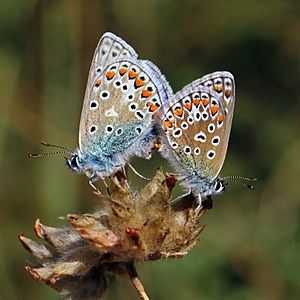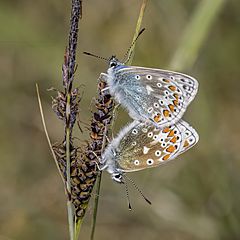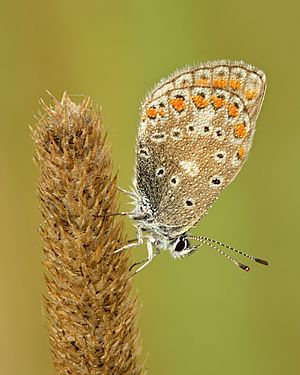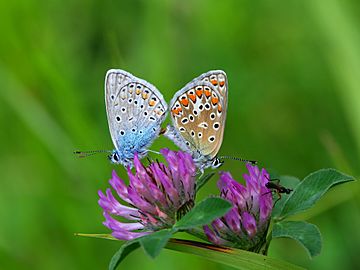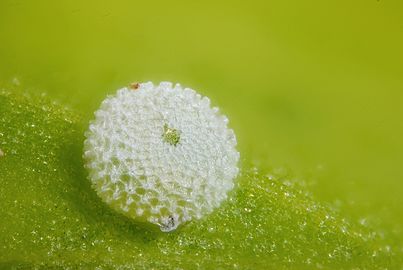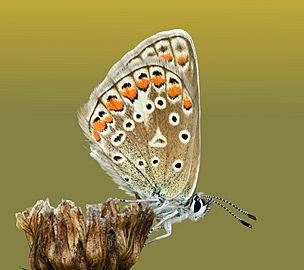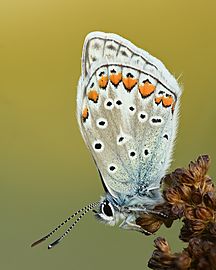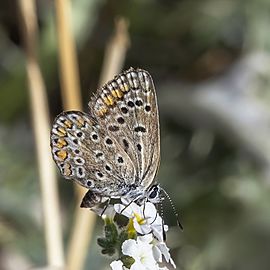Common blue facts for kids
Quick facts for kids Common blue |
|
|---|---|
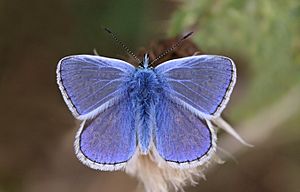 |
|
| Male | |
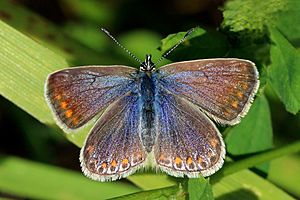 |
|
| Female both in Oxfordshire |
|
| Conservation status | |
| Scientific classification | |
| Synonyms | |
|
The Common Blue butterfly (its scientific name is Polyommatus icarus) is a beautiful insect. It belongs to the Lycaenidae family, which includes many butterflies often called 'blues' because of their wing colors. You can find this butterfly across a huge area called the Palearctic region.
Male Common Blue butterflies usually have bright blue wings with a thin black border and white edges. Females are often brown with some blue near their bodies and orange spots along the edges.
In 2023, the Common Blue was chosen as the national butterfly of Israel.
Contents
What is the Common Blue Butterfly?
This butterfly was first described by Siegmund Adrian von Rottemburg in 1775. People have given it many other names over time, like "little blew argus" or "ultramarine blue."
Different Types of Common Blue Butterflies
Just like there are different breeds of dogs, there are slightly different types of Common Blue butterflies. These are called subspecies. Some examples include:
- P. i. icarus (found in Europe and Caucasus)
- P. i. mariscolore (found in Ireland)
- P. i. fuchsi (found in South Siberia)
- P. i. fugitiva (found in Pakistan)
-
Female P. i. mariscolore in County Clare, Ireland
-
Mating P. i. mariscolore in County Clare, Ireland
How to Identify a Common Blue Butterfly
The Common Blue butterfly has a wingspan of about 28 to 36 millimeters (about 1 to 1.4 inches). The top side of the male's wings is a shiny blue color with a thin black border. Female wings are usually brown or black-brown. They have a row of red or orange spots along the edges. Females might also have some blue near the base of their wings. The amount of blue on females can change a lot depending on where they live.
The underside of the wings is grayish in males and more brownish in females. Both sexes have a row of red or orange spots along the edge of their hindwings. They also have about a dozen black-centered white spots, called ocelli. These spots help tell them apart from other similar butterflies. The white fringes on the outer edge of their wings are solid white, not striped.
Other butterflies that look similar to the Common Blue include:
- Polyommatus semiargus
- Polyommatus coridon
- Polyommatus dorylas
The caterpillar of the Common Blue is small and pale green. It has yellow stripes and looks a bit like a slug.
Where Do Common Blue Butterflies Live?
The Common Blue butterfly lives in Europe, North Africa, the Canary Islands, and across the Palearctic region to Northern China. It is very common in the British Isles. Sadly, its numbers have dropped by about 15% since the 1970s.
Common Blue in the UK and Ireland
This butterfly is the most common and widespread 'blue' butterfly in Britain and Ireland. You can find it as far north as Orkney and on most of the Outer Hebrides. It lives in many grassy places, like meadows, coastal dunes, and woodland clearings. It also lives in places made by people, as long as its food plants are there.
Common Blue in North America
The Common Blue butterfly is a new species in eastern Canada. It was first found in Mirabel, Quebec, Canada, between 2005 and 2008. It seems to be settling in well and spreading to new areas each year. Studies show it likes places with more city development. This is because its favorite food plant, bird's foot trefoil, grows well there.
What Kind of Places Do They Like?
These butterflies like places with lots of flowers or grass. They can live in warm or cool areas, open fields, or wooded spots. You can find them from sea level up to high mountain meadows, as high as 2,700 meters (about 8,850 feet). They often live on chalk or limestone grasslands. They also appear in smaller numbers in woodland clearings, meadows, and sand dunes.
Why Are Their Numbers Declining?
The Common Blue used to be very common across Europe and Asia. It was one of the most widespread butterflies in Britain. However, its population has dropped by an estimated 74% since 1901. This decline might be because 46% of its favorite food plant, bird's foot trefoil (Lotus corniculatus), has also disappeared since 1901. This plant is important because it provides food for both adult butterflies and their caterpillars.
What Do Common Blue Butterflies Eat?
Caterpillar Food Plants
The caterpillars of the Common Blue butterfly eat plants from the bean family, called Leguminosae. Some of their favorite food plants include bird's foot trefoil (Lotus corniculatus), black medick (Medicago lupulina), and white clover (Trifolium repens).
Special Pigments from Plants
Common Blue butterflies take special colored substances called flavonoids from the plants they eat. These pigments absorb UV light and are stored in their wings. In female butterflies, these flavonoid pigments help attract males. Males look for females with these pigments because they make the females' colors brighter and more noticeable.
These pigments also help protect the butterfly's eggs from harmful UV rays. They can even offer a defense against predators or diseases. Females collect about 60% more flavonoids than males. This might help males know which females are healthy and good mates.
Life Cycle of the Common Blue Butterfly
As a caterpillar, the Common Blue eats leaves. As an adult butterfly, it drinks nectar from wildflowers. Adult butterflies usually live for about three weeks.
Male butterflies are often easy to spot. They fly around defending their areas and looking for females. In southern Britain, there are two main groups of butterflies each year. One group flies in May and June, and another in August and September. In northern England, there is usually one group that flies between June and September. If the weather is warm for a long time, a third group might appear in the south in October.
Eggs
The egg stage lasts about eight days. The eggs are white and shaped like flattened spheres. They are very small, about 0.60 millimeters (0.02 inches) across. Eggs are laid one by one on young shoots of the food plant.
Larvae (Caterpillars)
Caterpillars hatch about one to two weeks after the eggs are laid. Common Blue caterpillars eat the underside of leaves, which causes spots to appear. They spend the winter as half-grown caterpillars.
These caterpillars are attractive to certain types of ants, like those from the Myrmica and Lasius groups. The caterpillars produce a sweet liquid called honeydew, which the ants love to eat. In return, the ants often protect the caterpillars and even carry them into their nests. This relationship is a type of mutualism, where both the ants and the caterpillars benefit.
Caterpillar Growth Stages
Common Blue caterpillars go through five growth stages, called instars.
- In the first stage, the larva hatches and eats part of the egg. It is light green and lasts about nine days.
- After its first molt, in the second stage, the larva grows a bit more.
- In the third stage, the larva eats and grows larger, reaching about 3.2 millimeters (0.12 inches) long. Its head and legs are black.
- In the fourth and fifth stages, the larva becomes very green. It has ten body segments and can grow to about 13 millimeters (0.5 inches) long.
The speed at which caterpillars grow depends on the temperature and the quality of their food. Caterpillars born earlier in the season take longer to develop than those born later.
Pupae
The pupa stage lasts about two weeks. The caterpillar turns into a chrysalis at the base of its food plant. The chrysalis is olive green or brown. Ants often attend the chrysalis, protecting it and sometimes even burying it to keep it safe from predators.
Adult Butterflies
Male butterflies are brighter blue and more noticeable than females, which have brown upper wings. Males fly longer distances looking for areas where they can find females. Females fly lower, searching for nectar and places to lay their eggs. When a male and female meet, they usually mate right away without a special dance or ritual.
How Do Common Blue Butterflies See?
Butterflies have amazing ways of seeing colors. The Common Blue butterfly uses special light-sensing cells in its eyes to see colors. It can see colors in the green part of the light spectrum. It can tell the difference between yellow and blue, but not between yellow and red.
Why is it Called "Icarus"?
The scientific name Polyommatus icarus comes from an old Greek story. In Greek mythology, Icarus was a boy who flew too close to the sun with wings made of feathers and wax. The wax melted, and he fell into the sea.
See also
 In Spanish: Mariposa ícaro para niños
In Spanish: Mariposa ícaro para niños
- Butterflies of Asia
- Butterflies of Europe
- List of butterflies of Great Britain



